

Critical Thinking. The Surprising Truth About Learning in Schools. 12 Strategies For Creating An Atmosphere Of Problem-Solving In Your Classroom - 26 Sentence Stems For Higher-Level Discussion In The Classroom. 26 Sentence Stems For Higher-Level Conversation In The Classroom by Terry Heick Note: You can purchase a similar, classroom-ready version of these stems on printable cards, if you find that useful.

Meaningful conversation can make learning more personal, immediate, and emotional. During meaningful conversations, students are forced to be accountable for their positions, to listen, to analyze opposing perspectives, and to adapt their thinking on the fly. There are many popular strategies for these kinds of conversations, each with slightly unique rules and applications. Creating Students That Solve Problems. Can we have an honest conversation about phones in the classroom? - A.J. JULIANI. I get to visit a lot of schools around the country, and I’ll admit that when I see signs like the one below, I often cringe.

It’s not the sign’s fault, but I can’t help but think what kind of message this sends to our students. We don’t have these types of signs for anything else outside most classrooms. There aren’t many signs saying “no drugs in this classroom” or “no weapons in this classroom” or “no cursing in this classroom” (I’m sure some of these exist). The pervasiveness of these types of signs speaks to a varying difference in opinion between educators everywhere. We all agree on most of the “things” that aren’t allowed in school and our classrooms. Yet, cell phones tend to bring out a strong opinion on either side, without much focus on the gray.
The Argument Against Cell Phones I was looking up resources and articles on this topic as I was writing this article. While some of these reasons may seem ridiculous to those of you reading this article. The Argument for Cell Phones.
Are You Teaching Content Or Teaching Thought? - Are You Teaching Content, Or Teaching Thought?

New Pedagogies for Deep Learning - The Learning Exchange. Rick Wormeli: The Right Way to Do Redos. Adapted from Fair Isn’t Always Equal: Assessing and Grading in the Differentiated Classroom by Rick Wormeli.

Copyright © 2006, Stenhouse Publishers. All rights reserved. Cognitive Load Theory and Why Students Are Answer-Obsessed – Teaching With Problems. It’s true: math education doesn’t give a ton of attention to Sweller and cognitive load theory.
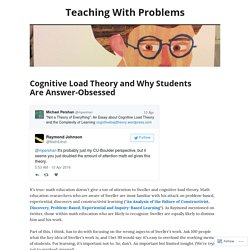
6 Powerful Learning Strategies You MUST Share with Students. How Giving Students Choice During the Day Can Create Unstoppable Learning. By Maricela Montoy-Wilson A version of this post originally ran on the Teaching Channel’s Tcher’s Voice blog.
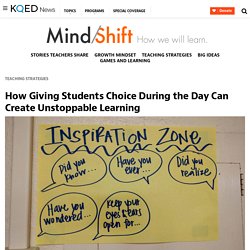
I came back from my morning run completely energized. 8 Strategies To Make Lasting Change In The Way You Teach. 8 Strategies To Make Lasting Change In The Way You Teach by TeachThought Staff You’ve likely read about something recently that caught your eye.
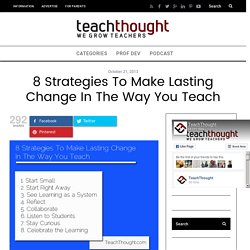
Game-Based Learning. A new app. A comprehensive literacy strategy. The Padagogy Wheel – It’s Not About The Apps, It’s About The Pedagogy - TeachThought PD. 30 Habits Of Highly Effective Teachers. Editor’s Note: We often look at the qualities and characteristics of good teaching and learning, including the recent following pieces: How A Good Teacher Becomes Great What You Owe Your Students Ten Secrets To Surviving As A Teacher The Characteristics Of A Highly Effective Learning Environment How To Be A Mediocre Teacher 25 Things Successful Teachers Do Differently.
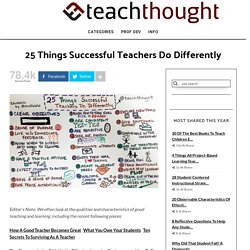
The Teacher's Guide To Flipped Classrooms.
A Comprehensive List of Apps and Tools to Flip your Classroom. For those of you intent on employing the flipped learning model in their instruction, we have curated a set of important web tools to help you create the appropriate flipped classroom environment for your students.
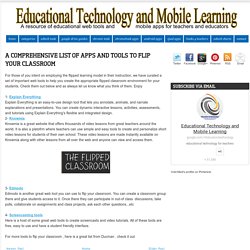
Check them out below and as always let us know what you think of them. Enjoy 1- Explain Everything Explain Everything is an easy-to-use design tool that lets you annotate, animate, and narrate explanations and presentations. You can create dynamic interactive lessons, activities, assessments, and tutorials using Explain Everything's flexible and integrated design. 2- Knowmia Knowmia is a great website that offers thousands of video lessons from great teachers around the world. It is also a platofrm where teachers can use simple and easy tools to create and personalize short video lessons for students of their own school.
Pedagogy and Student Behaviours #GreatTeaching. Every year should be a year of great teaching.
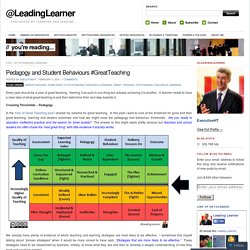
Naming it as such is one thing but actually achieving it is another. A teacher needs to have a clear idea of what great teaching is and then determine their next step towards it. Crossing Thresholds – Pedagogy In the Year of Great Teaching post I shared my schema for great teaching. 4 Amazingly Easy Steps to Engage Learners: Infographic. Classroom Management and the Flipped Class. Editor's Note:This post was co-authored by Aaron Sams, CEO of Sams Learning Designs, LLC and founding member of the Flipped Learning Network.
Let's face it. We teachers spend far too much time and energy trying to keep students quiet so that they can listen to us. We have taken countless courses and workshops on classroom management in our careers, and it seems that the underpinning goal of classroom management is for teachers to keep kids quiet so that they can learn. Skype in the Classroom - Skype in the classroom. Creating the Conditions for Student Motivation. Editor's Note: This piece was adapted from Building a Community of Self-Motivated Learners: Strategies to Help Students Thrive in School and Beyond by Larry Ferlazzo, available March 21, 2015 from Routledge.
There are three things to remember about education. The first is motivation. The second one is motivation. The third one is motivation. (former U.S. When students feel more motivated to learn, they perform better academically (PDF, 253KB), improve classroom behavior, and gain a higher sense of self-esteem. How To Use A Rubric Without Stifling Creativity. How To Use A Rubric Without Stifling Creativity by Grant Wiggins, Ph.D, Authentic Education It was not that long ago when I did a workshop where the staff from the Dodge Foundation (who were funding my work at the time) took me aside at the break because they were concerned with my constant use of a term that they had never heard of – rubric. Those of us promoting their use over the past 20 years can now smile and take satisfaction in the fact that the term is now familiar and the use of rubrics is commonplace world-wide.
Say What? 5 Ways to Get Students to Listen. Ah, listening, the neglected literacy skill. I know when I was a high school English teacher this was not necessarily a primary focus; I was too busy honing the more measurable literacy skills -- reading, writing, and speaking. But when we think about career and college readiness, listening skills are just as important. This is evidenced by the listening standards found in the Common Core and also the integral role listening plays in collaboration and communication, two of the four Cs of 21st century learning. 20% Time In My Classroom. Learning from mistakes.